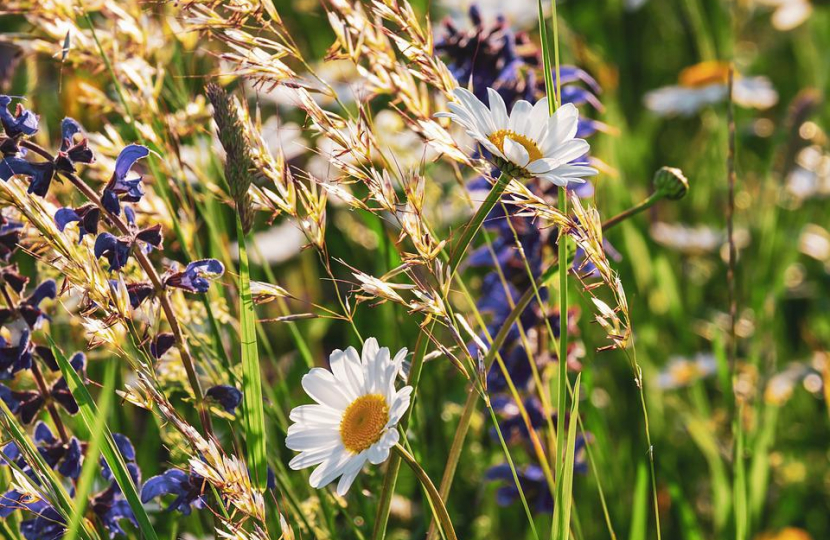
Sam Rowlands MS for North Wales, is backing a project to use natural methods to reduce and control grass at a Denbigh wildflower site. The scheme is being led by Denbighshire County Council.
He said:
I am delighted to hear about the success of this latest initiative. The pilot scheme in Lower Denbigh, which was trialled by the council’s biodiversity team last year, is now having a positive impact.
By using a natural technique the grass length has been reduced and the amount of wildflowers has increased which is great news for the future as this will mean more food for pollinating insects.
Local authorities have a responsibility to put a plan in place to enhance its biodiversity and clearly Denbighshire County Council are committed to doing so.
Part of the meadow in Lower Denbigh was scarified and Yellow Rattle seeds, harvested from another meadow in the town, were sown.
During this month the Biodiversity team inspected the site and found the grass length to be reduced, and wildflower abundance increased, where the trial had taken place.
Yellow rattle is a parasitic plant, tapping into the roots of grasses and other neighbouring plants and stealing their nutrients. This has reduced the dominance of grasses within the meadow, allowing more native wildflowers to take hold.
Yellow Rattle seeds from the Denbigh site are now set to be harvested to allow the plant to be introduced to other county wildflower meadow areas to reduce the dominance of grasses and help increase the number of wildflowers within the sites.
The Council’s Wildflower Meadows Project includes over 100 sites managed for wildflower meadow, including the 11 roadside nature reserves. These sites are equivalent to nearly 35 football pitches worth of grassland managed as native wildflower meadows.
All wildflower sites are managed in line with Plantlife’s Managing Grassland Road Verges guidelines which sees the grass cutting at these sites prohibited between March and August each year, giving wildflowers enough time to grow, flower, and set seed.
The site is then cut after August and cuttings collected to reduce soil fertility and provide the wildflowers with the best conditions possible.
Cefnogaeth Sam Rowlands AS i ymgyrch bioamrywiaeth yn Sir Ddinbych
Mae Sam Rowlands, yr AS dros Ogledd Cymru, yn cefnogi prosiect i ddefnyddio dulliau naturiol i leihau a rheoli glaswellt ar safle blodau gwyllt yn Ninbych. Mae’r cynllun yn cael ei arwain gan Gyngor Sir Ddinbych.
Dywedodd:
Rwy’n falch iawn o glywed am lwyddiant y fenter ddiweddaraf hon. Mae’r cynllun peilot yn Ninbych Isaf, a gafodd ei dreialu gan dîm bioamrywiaeth y cyngor y llynedd, bellach yn cael effaith gadarnhaol.
Drwy ddefnyddio techneg naturiol, mae’r glaswellt yn fyrrach a nifer y blodau gwyllt wedi cynyddu, sy’n newyddion gwych ar gyfer y dyfodol gan y bydd hyn yn golygu mwy o fwyd i bryfed sy’n peillio.
Mae gan awdurdodau lleol gyfrifoldeb i roi cynllun ar waith i wella ei fioamrywiaeth ac mae’n amlwg bod Cyngor Sir Ddinbych wedi ymrwymo i wneud hynny.
Crafwyd wyneb rhan o’r ddôl yn Ninbych Isaf a heuwyd hadau’r gribell felen, a gafodd eu cynhaeafu o ddôl arall yn y dref.
Yn ystod y mis hwn, bu’r tîm Bioamrywiaeth yn archwilio’r safle a chanfuwyd bod y glaswellt yn fyrrach a nifer y blodau gwyllt wedi cynyddu yn yr ardal ble cynhaliwyd y cynllun peilot.
Mae’r gribell felen yn blanhigyn parasitig, sy’n cysylltu â gwreiddiau gweiriau a phlanhigion cyfagos eraill ac yn dwyn eu maetholion. Mae hyn wedi lleihau goruchafiaeth gweiriau ar y ddôl, gan ganiatáu i fwy o flodau gwyllt brodorol dyfu.
Mae hadau’r gribell felen o safle Dinbych bellach ar fin cael eu cynaeafu er mwyn i’r planhigyn gael ei gyflwyno i ddolydd blodau gwyllt eraill y sir er mwyn lleihau goruchafiaeth gweiriau a helpu i gynyddu nifer y blodau gwyllt ar y safleoedd.
Mae Prosiect Dolydd Blodau Gwyllt y Cyngor yn cynnwys dros 100 o safleoedd dan reolaeth fel dolydd blodau gwyllt, gan gynnwys yr 11 gwarchodfa natur ymyl ffordd. Mae arwynebedd y safleoedd hyn yn cyfateb i bron i 35 cae pêl-droed o laswellt sy’n cael ei reoli fel dolydd blodau gwyllt brodorol.
Mae’r holl safleoedd blodau gwyllt yn cael eu rheoli yn unol â chanllawiau rheoli glaswelltir ar ymylon ffyrdd Plantlife, sy’n golygu gwahardd torri glaswellt ar y safleoedd hyn rhwng mis Mawrth a mis Awst bob blwyddyn, gan roi digon o amser i flodau gwyllt dyfu, blodeuo a hadu.
Mae’r glaswellt yn cael ei dorri pan fydd Awst drosodd, ac mae’r toriadau’n cael eu casglu i leihau ffrwythlondeb y pridd a rhoi’r amodau gorau posibl i’r blodau gwyllt.

